BTEC HND Business (Unit 23): Human Resource Development Task 1 Report
VerifiedAdded on 2023/04/11
|12
|654
|177
Report
AI Summary
This report, submitted as part of a BTEC HND in Business program, focuses on Human Resource Development (HRD). Task 1 of the assignment delves into comparing different learning styles, with a particular emphasis on Kolb's learning style and its application in organizational training programs. The report explores the importance of the learning curve and its influence on skill development within the workplace. Furthermore, it assesses the contribution of various learning styles and theories in the planning and design of effective learning events. The analysis considers how organizations can tailor training programs to accommodate diverse learning preferences and maximize the effectiveness of employee development initiatives. The report also includes references to relevant academic sources, supporting the analysis with credible research and insights.

HUMAN RESOURCE
DEVELOPMENT
(TASK 1)
DEVELOPMENT
(TASK 1)
Paraphrase This Document
Need a fresh take? Get an instant paraphrase of this document with our AI Paraphraser
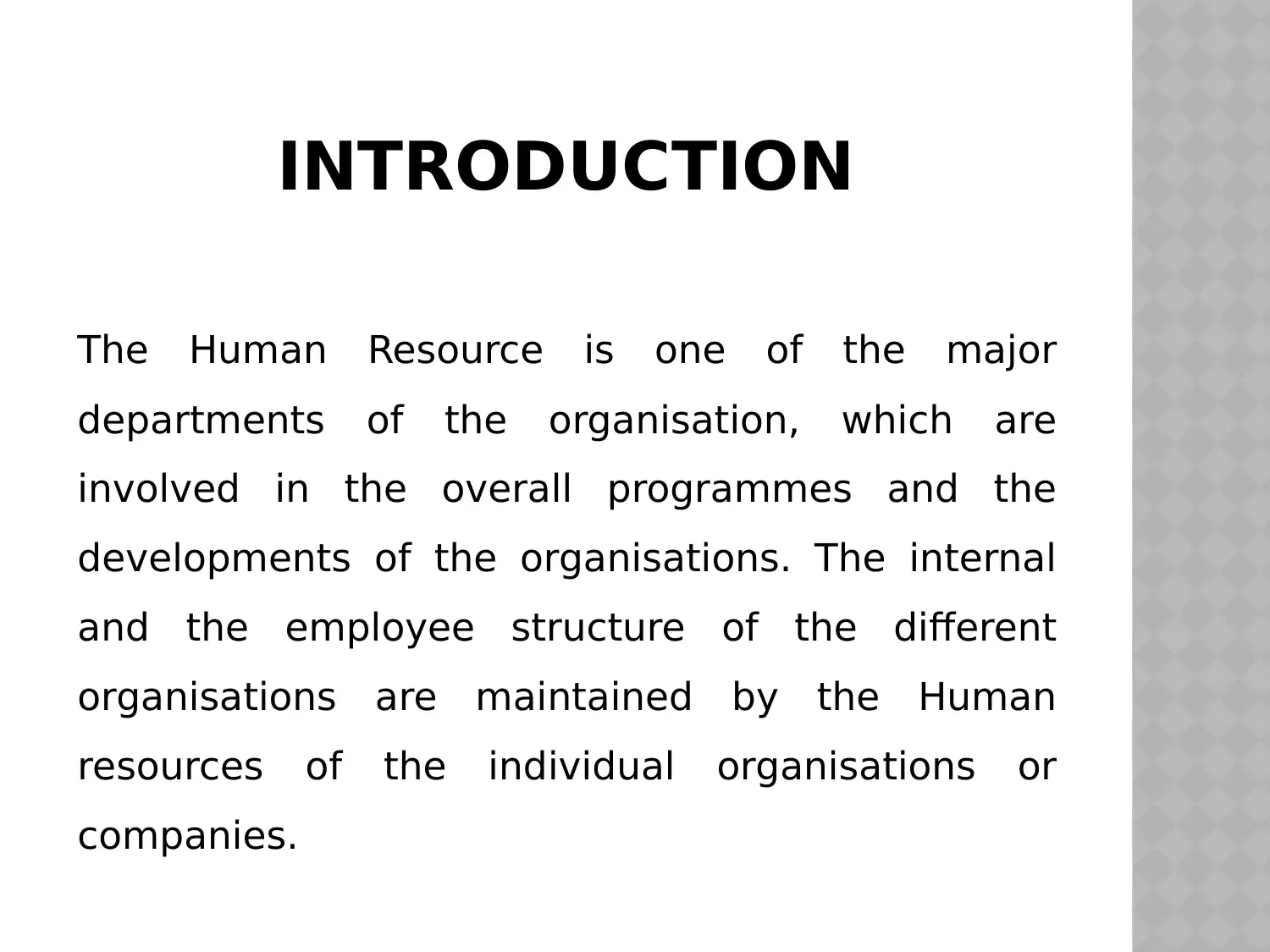
INTRODUCTION
The Human Resource is one of the major
departments of the organisation, which are
involved in the overall programmes and the
developments of the organisations. The internal
and the employee structure of the different
organisations are maintained by the Human
resources of the individual organisations or
companies.
The Human Resource is one of the major
departments of the organisation, which are
involved in the overall programmes and the
developments of the organisations. The internal
and the employee structure of the different
organisations are maintained by the Human
resources of the individual organisations or
companies.
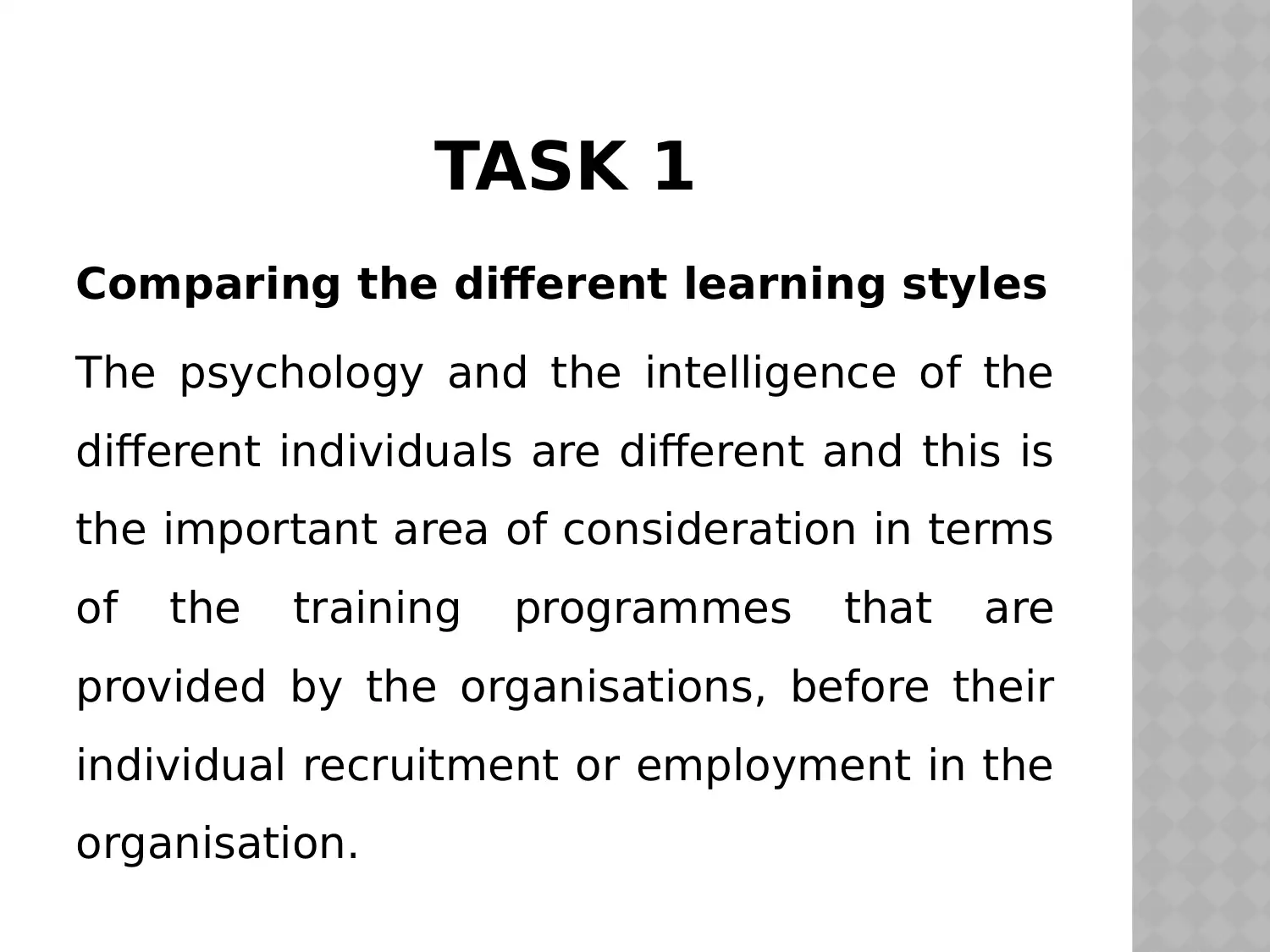
TASK 1
Comparing the different learning styles
The psychology and the intelligence of the
different individuals are different and this is
the important area of consideration in terms
of the training programmes that are
provided by the organisations, before their
individual recruitment or employment in the
organisation.
Comparing the different learning styles
The psychology and the intelligence of the
different individuals are different and this is
the important area of consideration in terms
of the training programmes that are
provided by the organisations, before their
individual recruitment or employment in the
organisation.
⊘ This is a preview!⊘
Do you want full access?
Subscribe today to unlock all pages.

Trusted by 1+ million students worldwide
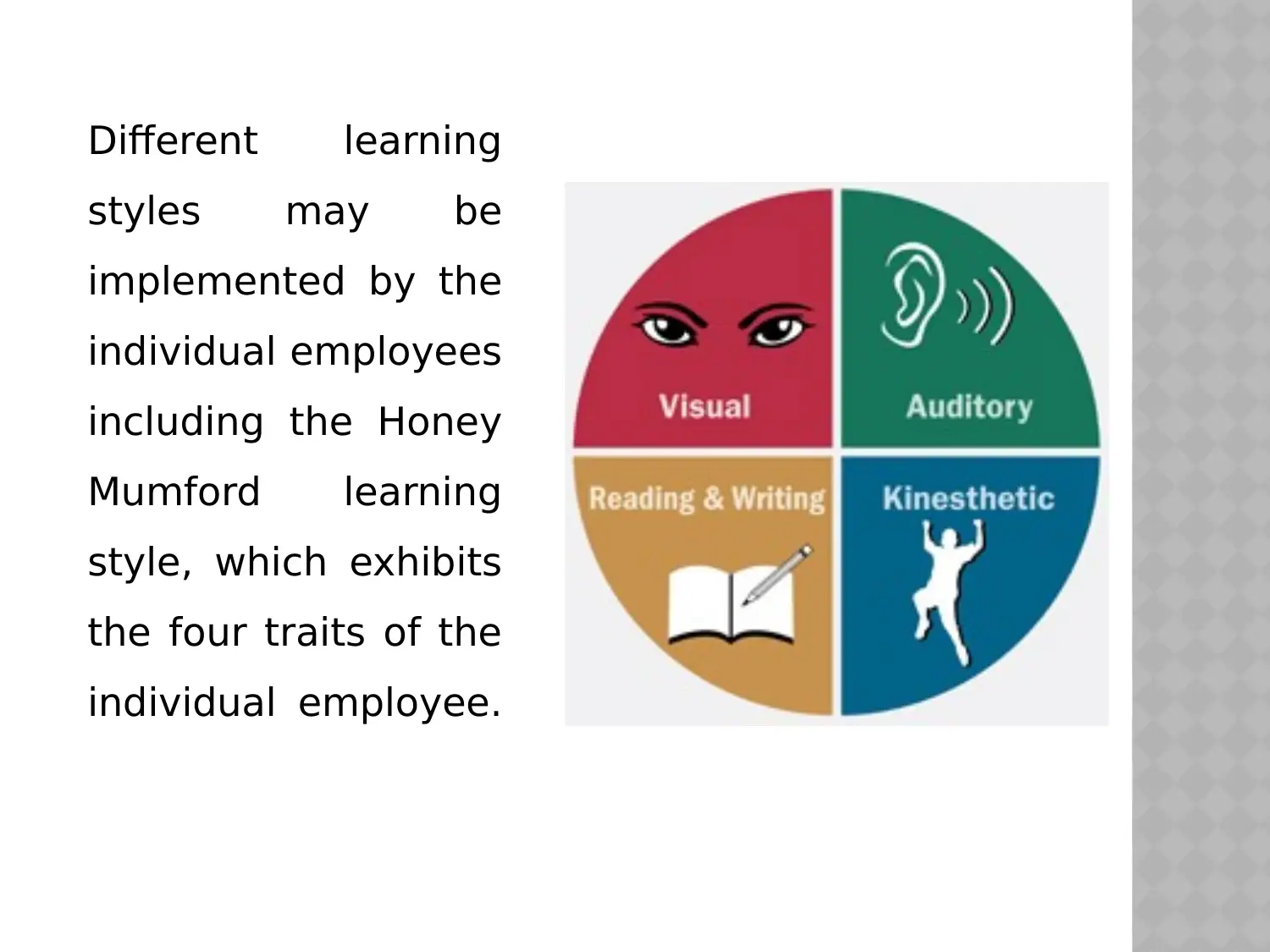
Different learning
styles may be
implemented by the
individual employees
including the Honey
Mumford learning
style, which exhibits
the four traits of the
individual employee.
styles may be
implemented by the
individual employees
including the Honey
Mumford learning
style, which exhibits
the four traits of the
individual employee.
Paraphrase This Document
Need a fresh take? Get an instant paraphrase of this document with our AI Paraphraser
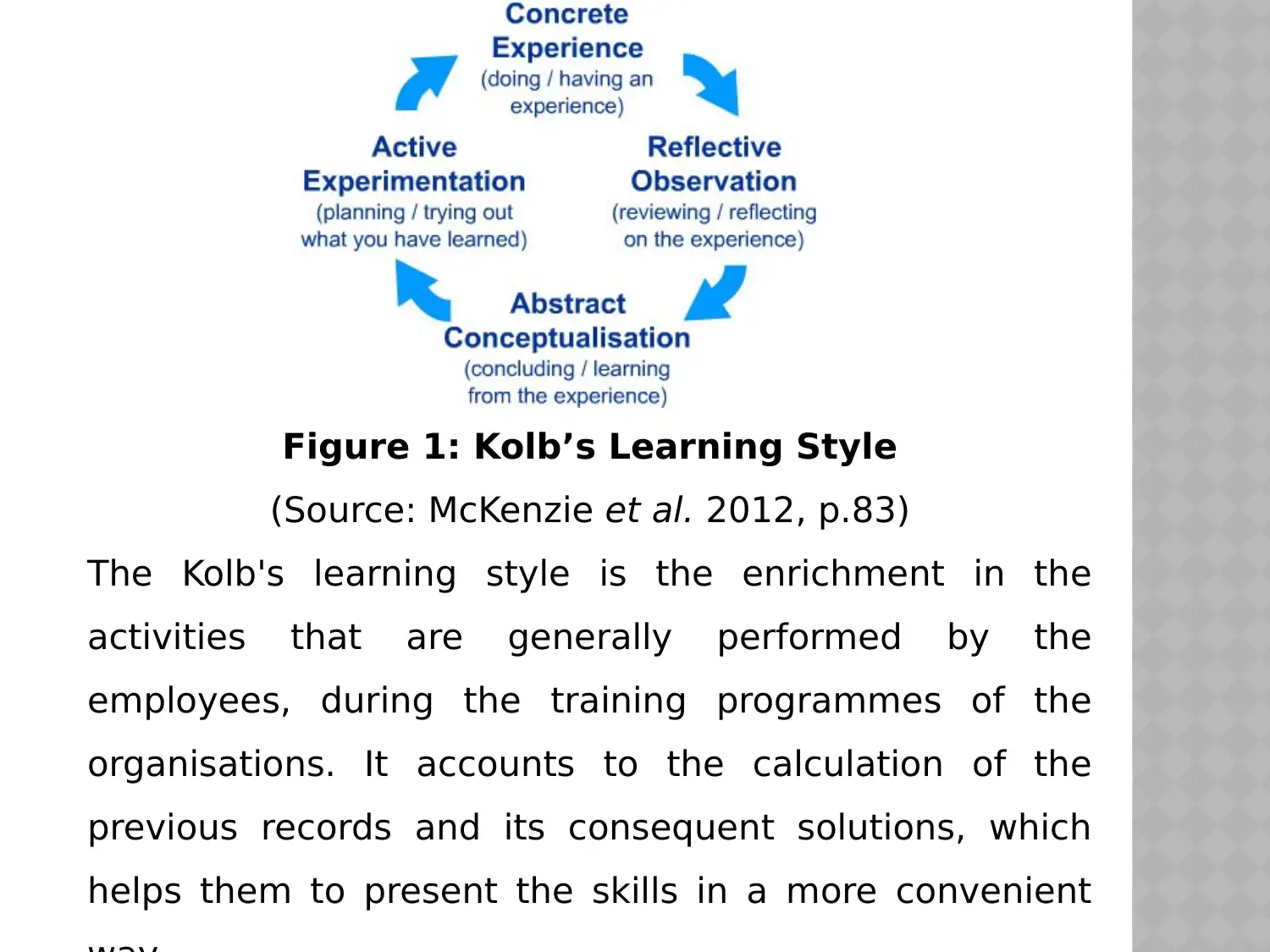
Figure 1: Kolb’s Learning Style
(Source: McKenzie et al. 2012, p.83)
The Kolb's learning style is the enrichment in the
activities that are generally performed by the
employees, during the training programmes of the
organisations. It accounts to the calculation of the
previous records and its consequent solutions, which
helps them to present the skills in a more convenient
(Source: McKenzie et al. 2012, p.83)
The Kolb's learning style is the enrichment in the
activities that are generally performed by the
employees, during the training programmes of the
organisations. It accounts to the calculation of the
previous records and its consequent solutions, which
helps them to present the skills in a more convenient
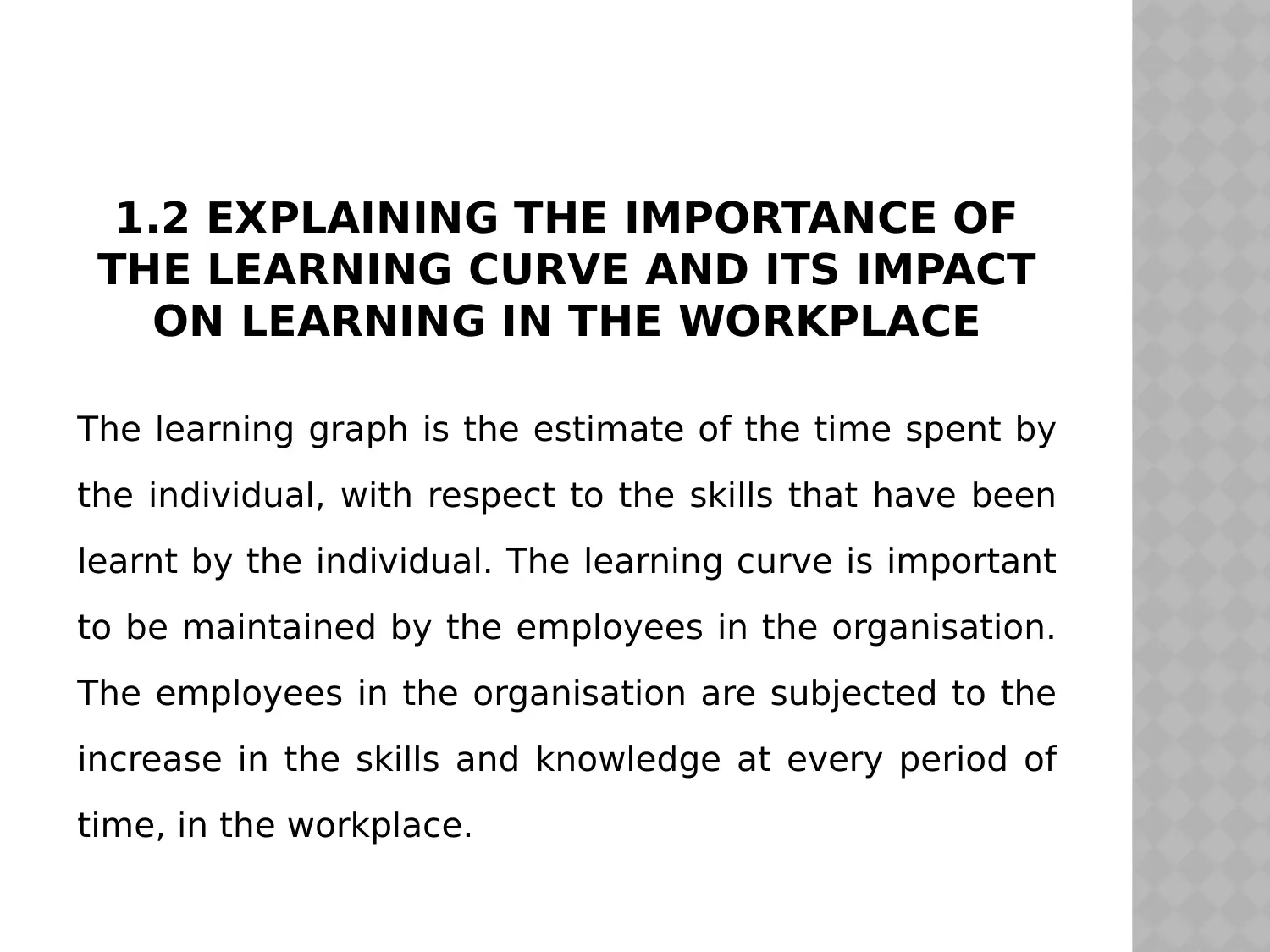
1.2 EXPLAINING THE IMPORTANCE OF
THE LEARNING CURVE AND ITS IMPACT
ON LEARNING IN THE WORKPLACE
The learning graph is the estimate of the time spent by
the individual, with respect to the skills that have been
learnt by the individual. The learning curve is important
to be maintained by the employees in the organisation.
The employees in the organisation are subjected to the
increase in the skills and knowledge at every period of
time, in the workplace.
THE LEARNING CURVE AND ITS IMPACT
ON LEARNING IN THE WORKPLACE
The learning graph is the estimate of the time spent by
the individual, with respect to the skills that have been
learnt by the individual. The learning curve is important
to be maintained by the employees in the organisation.
The employees in the organisation are subjected to the
increase in the skills and knowledge at every period of
time, in the workplace.
⊘ This is a preview!⊘
Do you want full access?
Subscribe today to unlock all pages.

Trusted by 1+ million students worldwide
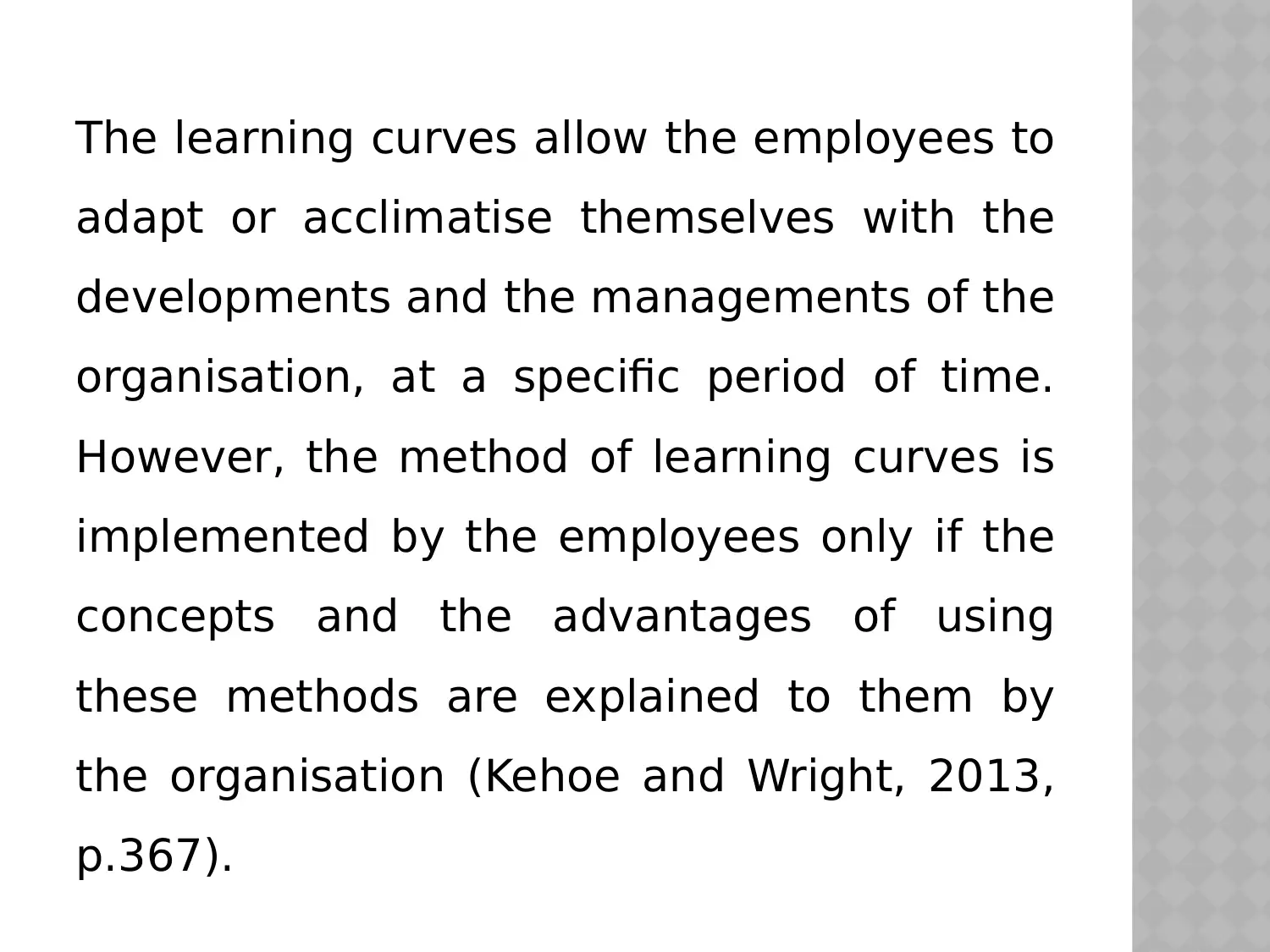
The learning curves allow the employees to
adapt or acclimatise themselves with the
developments and the managements of the
organisation, at a specific period of time.
However, the method of learning curves is
implemented by the employees only if the
concepts and the advantages of using
these methods are explained to them by
the organisation (Kehoe and Wright, 2013,
p.367).
adapt or acclimatise themselves with the
developments and the managements of the
organisation, at a specific period of time.
However, the method of learning curves is
implemented by the employees only if the
concepts and the advantages of using
these methods are explained to them by
the organisation (Kehoe and Wright, 2013,
p.367).
Paraphrase This Document
Need a fresh take? Get an instant paraphrase of this document with our AI Paraphraser
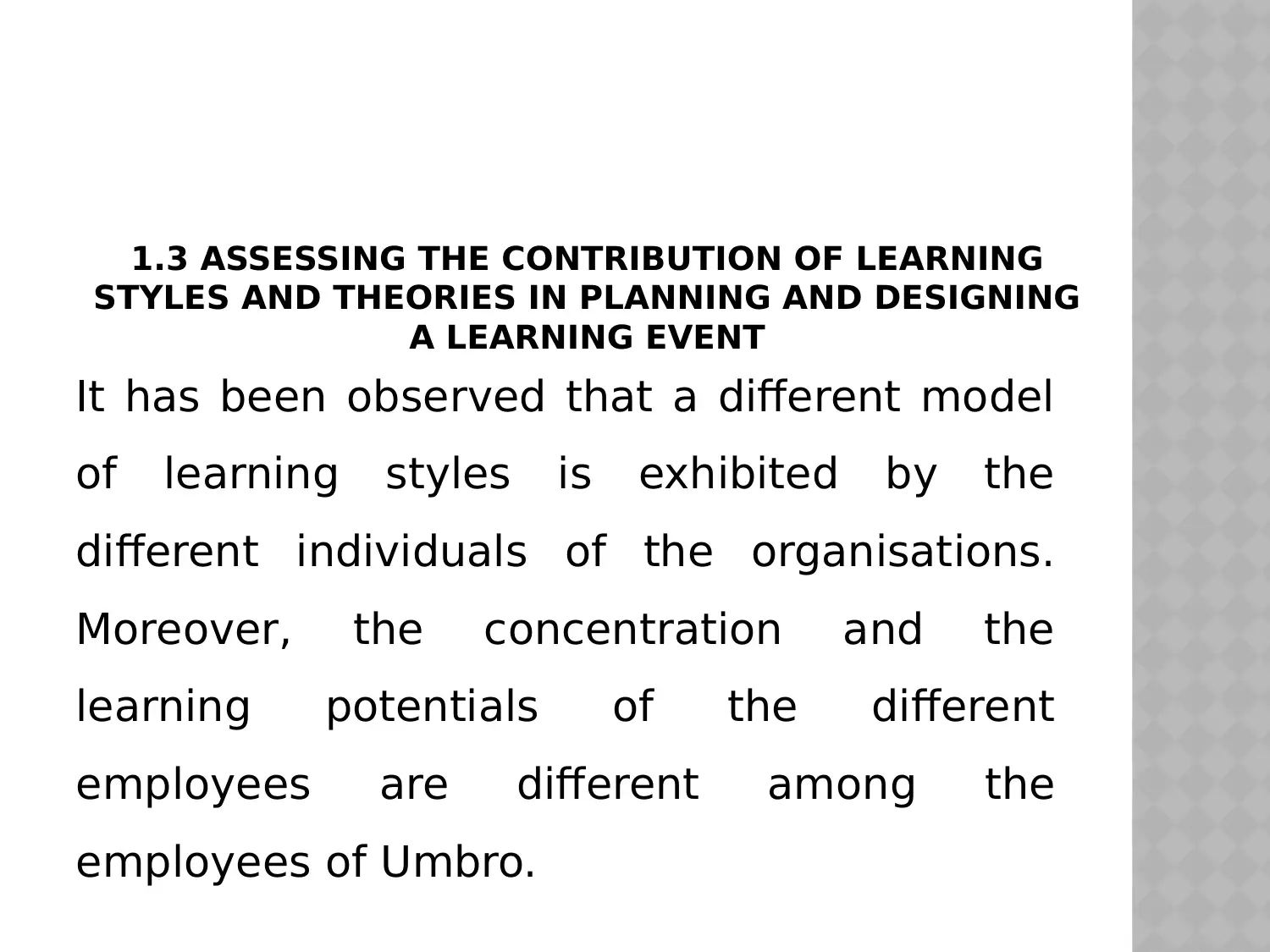
1.3 ASSESSING THE CONTRIBUTION OF LEARNING
STYLES AND THEORIES IN PLANNING AND DESIGNING
A LEARNING EVENT
It has been observed that a different model
of learning styles is exhibited by the
different individuals of the organisations.
Moreover, the concentration and the
learning potentials of the different
employees are different among the
employees of Umbro.
STYLES AND THEORIES IN PLANNING AND DESIGNING
A LEARNING EVENT
It has been observed that a different model
of learning styles is exhibited by the
different individuals of the organisations.
Moreover, the concentration and the
learning potentials of the different
employees are different among the
employees of Umbro.
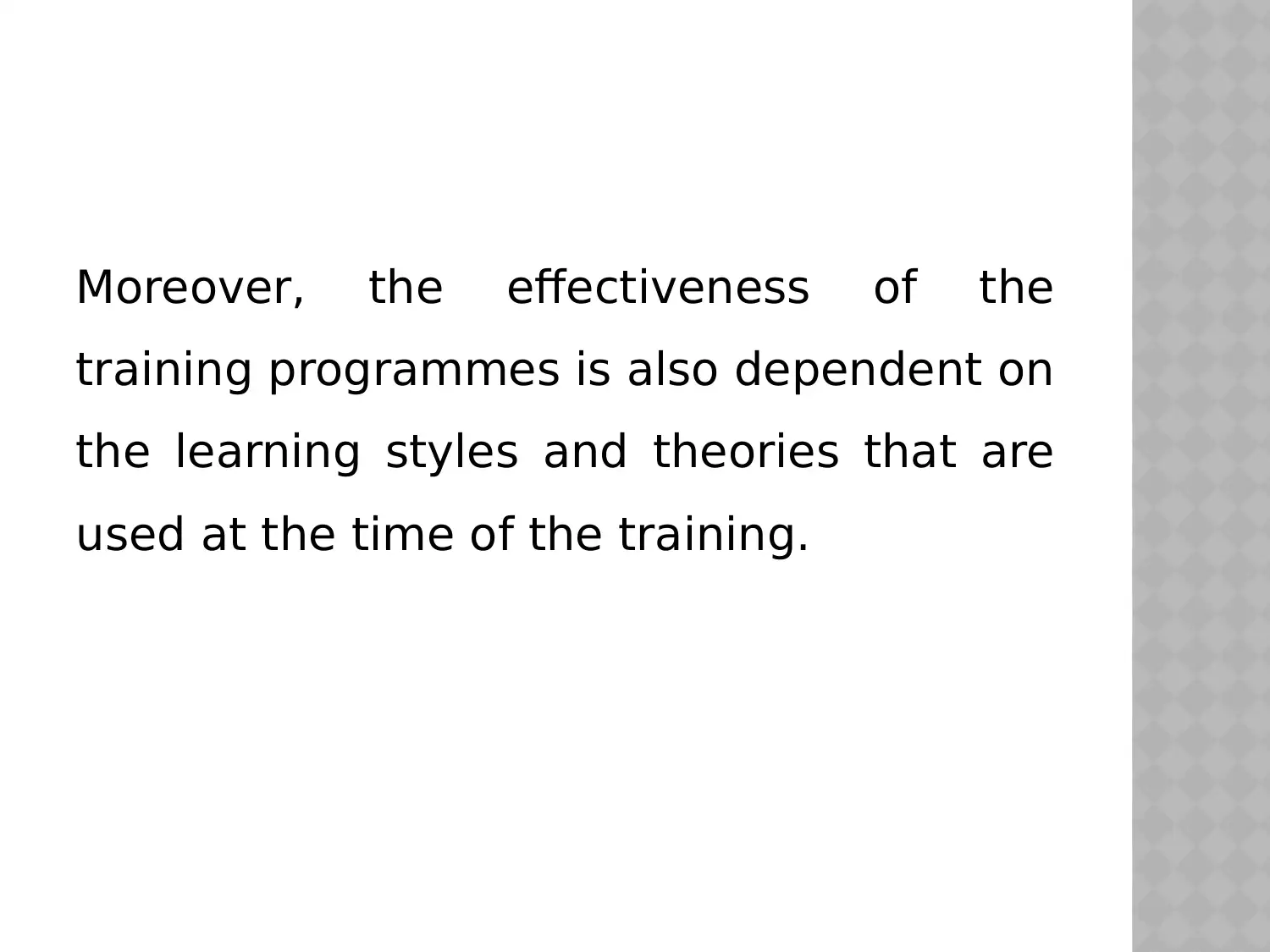
Moreover, the effectiveness of the
training programmes is also dependent on
the learning styles and theories that are
used at the time of the training.
training programmes is also dependent on
the learning styles and theories that are
used at the time of the training.
⊘ This is a preview!⊘
Do you want full access?
Subscribe today to unlock all pages.

Trusted by 1+ million students worldwide
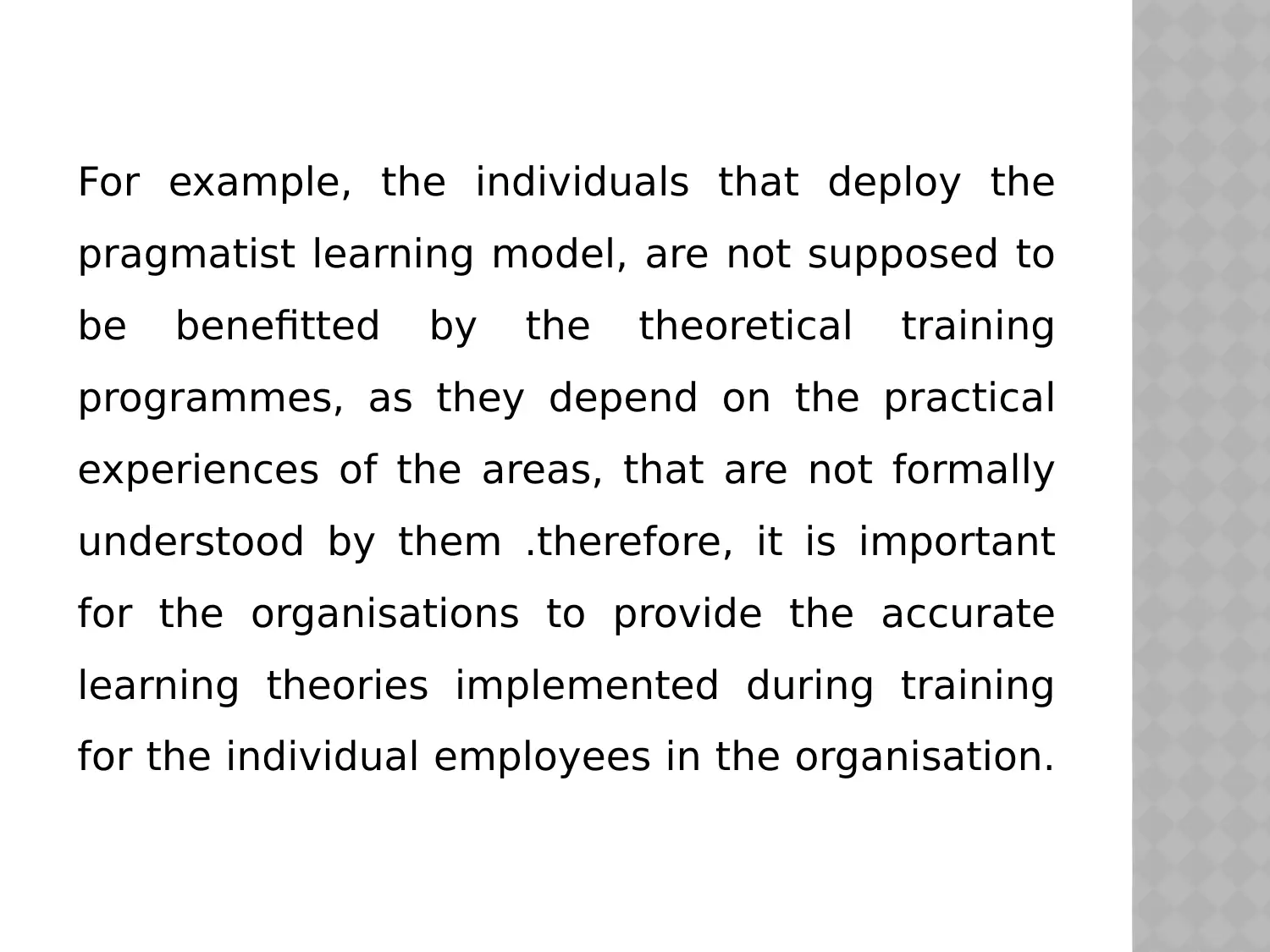
For example, the individuals that deploy the
pragmatist learning model, are not supposed to
be benefitted by the theoretical training
programmes, as they depend on the practical
experiences of the areas, that are not formally
understood by them .therefore, it is important
for the organisations to provide the accurate
learning theories implemented during training
for the individual employees in the organisation.
pragmatist learning model, are not supposed to
be benefitted by the theoretical training
programmes, as they depend on the practical
experiences of the areas, that are not formally
understood by them .therefore, it is important
for the organisations to provide the accurate
learning theories implemented during training
for the individual employees in the organisation.
Paraphrase This Document
Need a fresh take? Get an instant paraphrase of this document with our AI Paraphraser
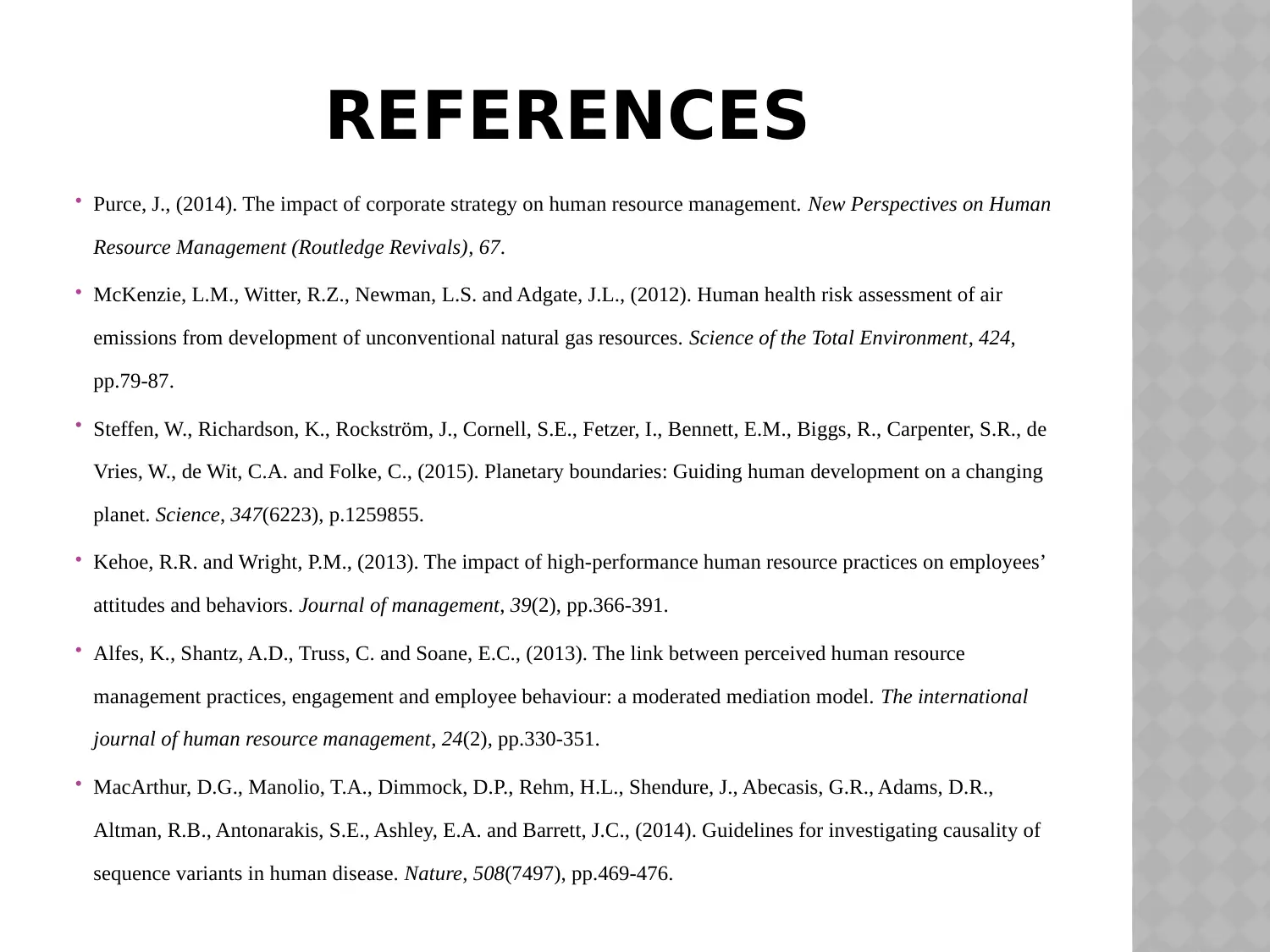
REFERENCES
Purce, J., (2014). The impact of corporate strategy on human resource management. New Perspectives on Human
Resource Management (Routledge Revivals), 67.
McKenzie, L.M., Witter, R.Z., Newman, L.S. and Adgate, J.L., (2012). Human health risk assessment of air
emissions from development of unconventional natural gas resources. Science of the Total Environment, 424,
pp.79-87.
Steffen, W., Richardson, K., Rockström, J., Cornell, S.E., Fetzer, I., Bennett, E.M., Biggs, R., Carpenter, S.R., de
Vries, W., de Wit, C.A. and Folke, C., (2015). Planetary boundaries: Guiding human development on a changing
planet. Science, 347(6223), p.1259855.
Kehoe, R.R. and Wright, P.M., (2013). The impact of high-performance human resource practices on employees’
attitudes and behaviors. Journal of management, 39(2), pp.366-391.
Alfes, K., Shantz, A.D., Truss, C. and Soane, E.C., (2013). The link between perceived human resource
management practices, engagement and employee behaviour: a moderated mediation model. The international
journal of human resource management, 24(2), pp.330-351.
MacArthur, D.G., Manolio, T.A., Dimmock, D.P., Rehm, H.L., Shendure, J., Abecasis, G.R., Adams, D.R.,
Altman, R.B., Antonarakis, S.E., Ashley, E.A. and Barrett, J.C., (2014). Guidelines for investigating causality of
sequence variants in human disease. Nature, 508(7497), pp.469-476.
Purce, J., (2014). The impact of corporate strategy on human resource management. New Perspectives on Human
Resource Management (Routledge Revivals), 67.
McKenzie, L.M., Witter, R.Z., Newman, L.S. and Adgate, J.L., (2012). Human health risk assessment of air
emissions from development of unconventional natural gas resources. Science of the Total Environment, 424,
pp.79-87.
Steffen, W., Richardson, K., Rockström, J., Cornell, S.E., Fetzer, I., Bennett, E.M., Biggs, R., Carpenter, S.R., de
Vries, W., de Wit, C.A. and Folke, C., (2015). Planetary boundaries: Guiding human development on a changing
planet. Science, 347(6223), p.1259855.
Kehoe, R.R. and Wright, P.M., (2013). The impact of high-performance human resource practices on employees’
attitudes and behaviors. Journal of management, 39(2), pp.366-391.
Alfes, K., Shantz, A.D., Truss, C. and Soane, E.C., (2013). The link between perceived human resource
management practices, engagement and employee behaviour: a moderated mediation model. The international
journal of human resource management, 24(2), pp.330-351.
MacArthur, D.G., Manolio, T.A., Dimmock, D.P., Rehm, H.L., Shendure, J., Abecasis, G.R., Adams, D.R.,
Altman, R.B., Antonarakis, S.E., Ashley, E.A. and Barrett, J.C., (2014). Guidelines for investigating causality of
sequence variants in human disease. Nature, 508(7497), pp.469-476.

⊘ This is a preview!⊘
Do you want full access?
Subscribe today to unlock all pages.

Trusted by 1+ million students worldwide
1 out of 12
Related Documents
Your All-in-One AI-Powered Toolkit for Academic Success.
+13062052269
info@desklib.com
Available 24*7 on WhatsApp / Email
![[object Object]](/_next/static/media/star-bottom.7253800d.svg)
Unlock your academic potential
Copyright © 2020–2025 A2Z Services. All Rights Reserved. Developed and managed by ZUCOL.





